Sam Hough, Construction Business Manager (UK), KOREC Group, reports from this year’s prestigious BITA (British and Irish Trading Alliance) Gala Ball and Awards Celebration
On Saturday 19th October, I was delighted to join KOREC’s Group Leadership Team at the biggest event in the BITA (British and Irish Trading Alliance) calendar, the Gala Ball and Awards Celebration. Held bi-annually at a prestigious location in London, this year the Raffles Hotel, the event is a fabulous coming together of prominent figures in the construction, property, financial, and hospitality industry providing opportunities for networking whilst also supporting charitable causes.
As one of the headline sponsors of the evening, it was an excellent opportunity for KOREC to connect with key figures across various industries such as Laing O’Rourke, John Sisk and Sons and Kelly Communications, and share the our ‘Measure, Map and Manage’ message with relation to the connected construction site, expanded on in the latest release of BITA’s publication ‘Networks’ with this piece below:

Pictured above (left to right), Mark Poveda (Managing Director – UK & Ireland), Sam Hough (Construction Business Manager (UK), Mark Reid (UK Sales Director), Alan Browne (Executive Chairman) and John McGoey (CEO at ECC Group)
Imagine a construction site powered by real-time data, a truly connected construction site enables a reduction in errors, the latest models are used for setting out, enhanced team collaboration, clearer communication, significant time and cost savings and increased project visibility. But how can that be achieved?
It’s a widely published figure that the cost of construction rework is estimated to represent between 2% and 20% of total costs, according to the Construction Industry Institute (CII) (average of 12%). Whilst we’re never going to live in a perfect world, consider how significantly that figure could decrease if every team member – from finance and design to engineering, surveying, and construction – worked from a single source of easily accessible, up-to-date data, including models, schedules, and documents?
Two Trimble solutions enable just that:
Trimble Connect is a cloud-based platform that allows project teams to share, view, and coordinate on construction models and data in real time. With an emphasis on collaboration, it supports the entire lifecycle of a construction project by providing a space where stakeholders can review 3D models, 2D drawings, 3D laser scans and other project files.
Trimble Viewpoint is a cloud-based construction management solution designed to integrate various aspects of a project, from accounting to project management, into one unified platform.
Together, they provide a seamless flow of data between project management and project execution.
Working with KOREC: Connected data in practice
KOREC specialises in the development, and subsequent roll-out of field to office workflows (using Trimble Viewpoint and Trimble Connect) and the integration of all your Trimble measuring and surveying equipment. The latest Building Safety Act imposes stricter requirements for as-built documentation. Trimble Connect can assist here covering all setting out data irrespective of the sensor used whether a total station, laser scanner or augmented reality.
A recent XYZ report, Constructing Tomorrow, states that the two main ways the industry is addressing errors and rework is through using advanced technology and equipment and better communication protocols, something that we are seeing increasingly backed up by KOREC customers, for example:
Mercury Engineering enhanced communication, minimised model errors and saved time across global teams by using Trimble’s XR10 mixed reality headset technology. The XR10 enabled the creation of sharable videos and images for a large-scale, three-floor data centre project, allowing the team to quickly identify potential issues and efficiently collaborate with remote members, who were often in different countries.
Walsh Steel Detailing (WSD) saved invaluable time on a recent large project using a Trimble X7 laser scanner and the XR10 mixed reality headset. Trimble Connect allowed for the seamless sharing of 3D models and real-time data, enabling remote and on-site teams to identify issues, ensure model accuracy, and collaborate efficiently, reducing errors and improving project delivery.
The team felt that the two technologies complimented each other perfectly with the X7 allowing WSD to bring the site to their office so they could model around it whilst the XR10 allowed them to verify the model on site and gain total client confidence in the work they were doing before any material was cut.
Laing O’Rourke used Trimble’s Connect AR augmented reality app to give their building construction workers even greater accessibility to 3D models in the field. The app runs on tablets and smartphones and via QR markers allows for easy positioning of 3D models whilst on the job site.
Trimble Connect AR has been designed to revolutionise QA/QC workflows through the viewing of digital models at 1:1 scale onsite and in context. This enables the Laing O’Rourke project team to validate the build, observe omissions, and visually collaborate to resolve issues.
They recently used the system on the prestigious Whiteley redevelopment in London. The versatility of the system was proved by positive feedback from three different teams, MEP, Structural and Design Engineering.
What next?
Trimble Viewpoint, Trimble Connect, and Trimble’s construction measurement portfolio are revolutionising the construction industry by enhancing efficiency, collaboration, and visibility. As technology advances, these platforms will be essential for the success of construction projects.
The construction team at KOREC is dedicated to empowering our customers to develop workflows that fully utilise these transformative tools.
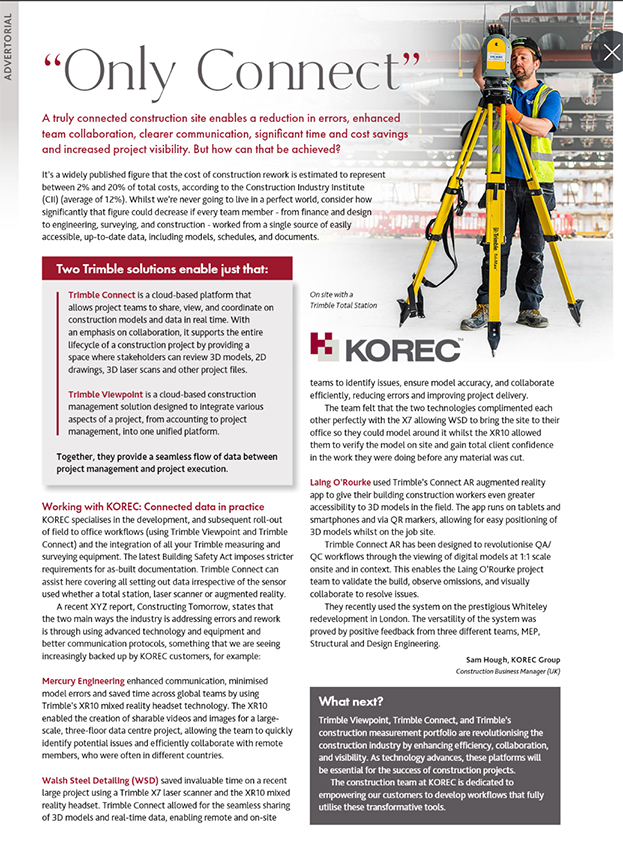
Trimble’s innovative technology is paving the way for more efficient and accurate building processes. Let’s build better together!
- Contact us on UK: 0345 603 1214 and IRE: 014564 702
- Follow Sam Hough on LinkedIn
- Visit www.korecgroup.com or www.facebook.com/TrimbleConstructionByKOREC
KOREC is proud to announce that we support both serving and former military personnel – by signing up to the Armed Forces Covenant.
Established over a decade ago by the UK Government, the Covenant is a pledge from the nation to our armed forces, that they will be respected, supported and treated fairly.
We’re in good company – joining over 10,000 other businesses and organisations of all sizes who have pledged their support.
KOREC has an existing military connection through one of our own –Philip McCarten, who joined KOREC in 2020 as a member of our geospatial technical support team.
Prior to this, Phil was a member of the 42 Engineer Regiment (Geographic) as a Field Surveyor and Geographic Technician for almost a quarter of a century. The specialist unit is made up of both regulars and reservists, and provides geographic information, survey capabilities and mapping products for the Armed Forces. During his time in the unit, Phil travelled the globe conducting surveys, training and advising personnel in all manner of geographic matters. He even won the prestigious Queen’s Commendation for Bravery for his actions in West Africa in 1998.
Of the news that KOREC has signed up to the Covenant, Phil said;
“I’m delighted that KOREC have signed up, and wanted to say thanks and well done. KOREC is a great place to work and emulates the same values that are at the core of the Armed Forces. I am looking forward to seeing how we, as an organization, implement the covenant in our day to day working, especially as our Huntingdon office is only 3 miles away from my old regiment’s base!”
What is the Covenant?
The Covenant supports current serving members, reservists, veterans, family members, and those who have been injured during their service lifetime.
For reservists in particular, the pledge allows them to balance their civilian work with their Armed Forces role – by providing additional paid leave for them to complete necessary training.
The Covenant opens up a wide variety of support, including;
- Help with purchasing a home
- Enhanced access to physical and mental healthcare
- Financial advice and support
- Support for Veterans via Veterans UK
Discover more about the Armed Forces Covenant, including the complete list of pledging organisations, via their website; https://www.armedforcescovenant.gov.uk/
We’ve always believed that the geospatial industry offers up some fabulous stories, great personalities and interesting points of view and that now’s as good a time as any to celebrate this with some quick fire interviews.
In the first of our ‘Latitude and Attitude’ series, we posed 10 questions to Mike Roller, Civil Engineering Surveyor, Galliford Try. Why did we pick Mike for our first post? Well, the KOREC team has been lucky enough to socialise with Mike at work related functions over the years, including a recent trip to Trimble Dimensions in Las Vegas, so we knew he’d be a safe bet for some great stories…. and that with over 30 years in the indsutry working for some of the biggest names including Balfour Beatty, Skanska and even Trimble, there was a rich vein to be mined. Mike didn’t disappoint!
Why did you choose a career in surveying?
I was advised by my then Maths teacher to take a one or two-day course run by Birkbeck College. I believe it was called Vocational Guidance. They gave me an IQ test and alternatives from which to choose that were basically indoor or outdoor, using your brain or your hands, arts or sciences…etc. They concluded I could achieve a maths degree and my aptitudes lay in something like Clerk of Works or Quantity Surveying. I tried for a job in Quantity Surveying and thought I’d try for one in Land Surveying as well thinking they must be similar. I got the job in Land Surveying.
If you weren’t a surveyor what would you be….
I tried to join the RAF as a Pilot Officer on a twelve-year commission. I passed the medical and got good marks in the flying aptitude tests during the first two days of a four-day course at Biggin Hill. Unfortunately, I didn’t get to the next two days as, during the interview at the end of the second day, I was deemed “not officer material”. It was only several years later while I was applying for Canadian citizenship (my dad was Canadian) that I discovered that my dad’s parents were Russian, which I felt may have actually been the reason, it was the 1960s, the Cold War etc…!
What was your most memorable survey moment?
I spent a year doing all the survey and setting-out for a five-kilometre conveyor belt for British Gypsum between their mine in Brightling and their processing plant at Mountfield, East Sussex. It was the first of its kind to follow the contours of the route rather than being a series of straight belts. The belt was pulled from the Mountfield end along a route which consisted of horizontal and vertical curves so any inaccuracy in the positioning could result in the belt being pulled off its rollers. When the M & E team came to commission the belt, they had allowed two months to tweak any problems. They started it up and it ran perfectly. They then loaded it with gypsum, and it continued to run perfectly so after two days they were on their way home!
What was your most dangerous survey moment?
Being shot while working in Iraq during the war with Iran in 1981. I still have the bullet lodged so close to my heart that the surgeon(s) thought it safer to leave it where it was than to try to remove it.
What was the best project you’ve worked on?
Lingfield all-weather racecourse. I carried out all the survey and setting-out for this contract during which time I was given free badges to bring my family to watch the horse racing free of charge. They were very enjoyable days out and we had three of them during the year I was working there.
What are your top three surveying tips?
Check, check, check.
Tell us about your favourite survey story
I worked for a year for the Eastern Road Construction Unit checking the setting-out of the alignment of the M11 as it was later to be known. I was checking the northern most section down to the A10, then three colleagues were doing the same for three more sections down as far as the North Circular Road. We used to meet up in a pub in Great Chesterford after work one or two evenings a week and on one particular evening, one of the other locals who was often in the pub after a train journey from London (let’s call him Simon, early thirties, not a surveyor) received a phone call on the pub’s land line…
Landlord: “Simon, it’s for you.”
Simon: “Hello? oh hello darling,” (pub goes a bit quiet, listening) “well, yes, about half an hour” (pub goes very quiet, listening intently by now), “oh alright then fifteen minutes.” Simon then replaces the receiver and announces to all listening “That ****** told her didn’t it?”
What is the best bit of survey technology you’ve used?
EDM.
If you could give one bit of advice to your younger self it would be….
I left after A Levels because I wanted to get away from school. I should have had a “Gap” year to get the leaving school idea out of my system and gone to university.
What next – do you have any unfulfilled dreams or aims?
When I was ten years old, my parents emigrated to Canada. There was my mum and dad, two sisters and a brother and we spent an enjoyable Atlantic Crossing by Cunard liner to Montreal, then a train journey to Winnipeg, where my dad’s parents were, then a car trip across the rest of Canada to the west coast to settle in British Columbia near Vancouver. Unfortunately, things didn’t work out for Dad, and we returned home after eight months but that’s another story. I intend to make a similar trip with my wife, driving to Vancouver, then driving south to California enjoying the views from the Pacific Coast Highway, then turn East to come back along Route 66 to Niagara Falls, then New York and home.
If you’d like to be a part of KOREC’s ’10 Questions’ series, drop us your name at: marketing@korecgroup.com
KOREC Group recruits software industry expert to lead large-scale expansion of its K-MATIC operations
The full release can be found here
We are delighted to announce the appointment of Gabriel Hradilek in the new position of Chief Operating Office of K-MATIC, our in-house software development division.
K-MATIC provides customisable solutions for the collection, analysis and processing of geospatial data through a combination of its K-CAPTURE field data capture software, its K-PORTAL and Trimble hardware solutions. Gabriel will manage the next stage in the expansion of these areas.
In this new role, Gabriel will be working alongside KOREC Group CEO Alan Browne, and K-MATIC Software Lead Paul Brodin, to manage an ambitious investment program that will see K-MATIC triple in size by the end of 2022. Specialising in deep industry-focused product and services software development, Gabriel brings experience from high profile previous roles working with global brands such as IBM.
KOREC Group CEO, Alan Browne said: “With a particular interest in helping companies absorb, apply and profit from disruptive digital technologies, Gabriel’s experience is a perfect fit for the ambitious plans we have for K-MATIC as we expand both the breadth and geographical potential of the software we develop.”
Gabriel Hradilek said: “I’m delighted to be taking up the role of Chief Operating Officer of K-MATIC. During my professional career I`ve worked with a number of deep industry-focused product and services software development organisations across the globe, big and small. However, very few of them were actually focused on creating their own market like K-MATIC does in the geospatial, engineering and construction sectors. Its innovative approach to solving the specific problems of a client or vertical market provide tremendous scope for a successful future.”
ENDS
Over the coming weeks, we’re going to be asking prominent people in the survey industry to outline their three most rated geospatial industry innovations/changes in around 100 words or so…and anything goes!
We’ll be sharing these thoughts on LinkedIn and have some great names lined up!
We’ll be adding each addition to our ‘Insider Series’ to the KOREC blog to build up a picture of what those in the know really rate.
Polly Hopkins, Company Secretary of Storm Geomatics, specialists in surveying in water
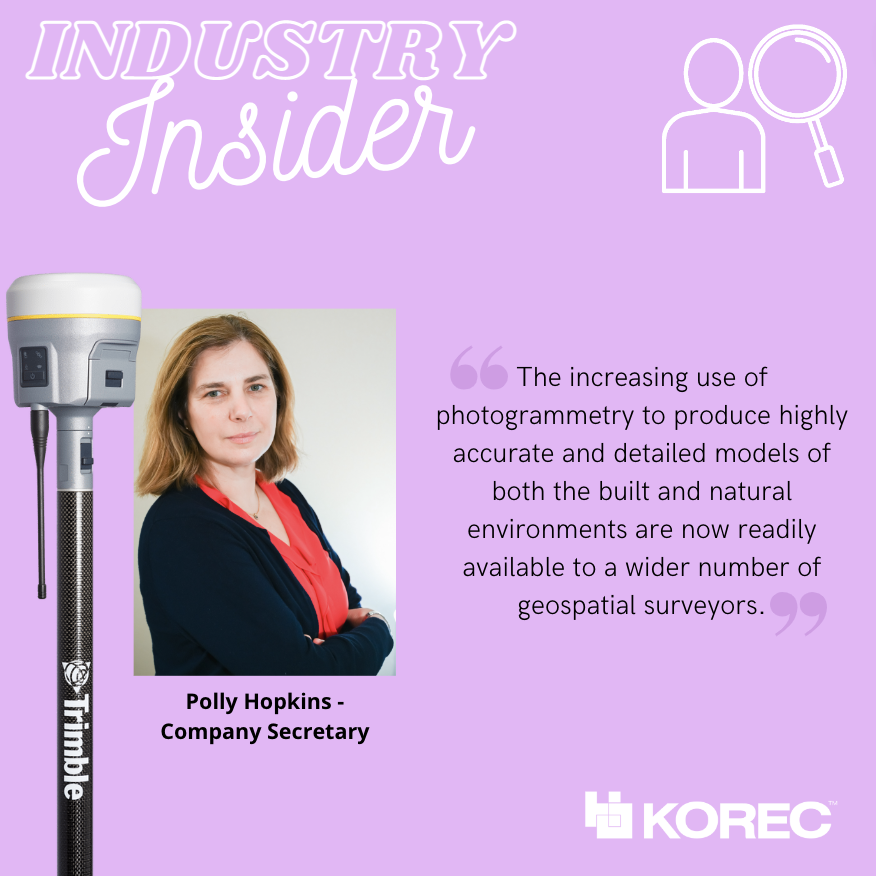
Polly has been with Storm Geomatics since day 1! Her expertise lies in understanding and researching Storm Geomatic’s clients’ pain points, then ensuring that her colleagues address these by providing solutions through the best methods of data capture.
Polly’s three most rated innovations/changes:
The increasing use of photogrammetry to produce highly accurate and detailed models of both the built and natural environments are now readily available to a wider number of geospatial surveyors. The increased use of photogrammetry is possible because of:
Increasing power and memory storage of computers too process large volumes of data and media that compliments data capture capabilities and processing. Such as photogrammetry.
Software innovation focusing on being specific to client needs to accelerate the process of problem solving. For example, GeoRiver® River Channel processing software that is a result of collaboration between Storm Geomatics and engineer clients to produce an understanding of specific requirements to solve flood solutions.
To conclude; photogrammetry, the power of the computer and functionality of software are all innovations that will greatly enhance geospatial data capture and ensure processing of data is accelerating the process of problem solving.
Ron Bisio, Senior Vice President at Trimble, with responsibility for the Geospatial and Transportation sectors
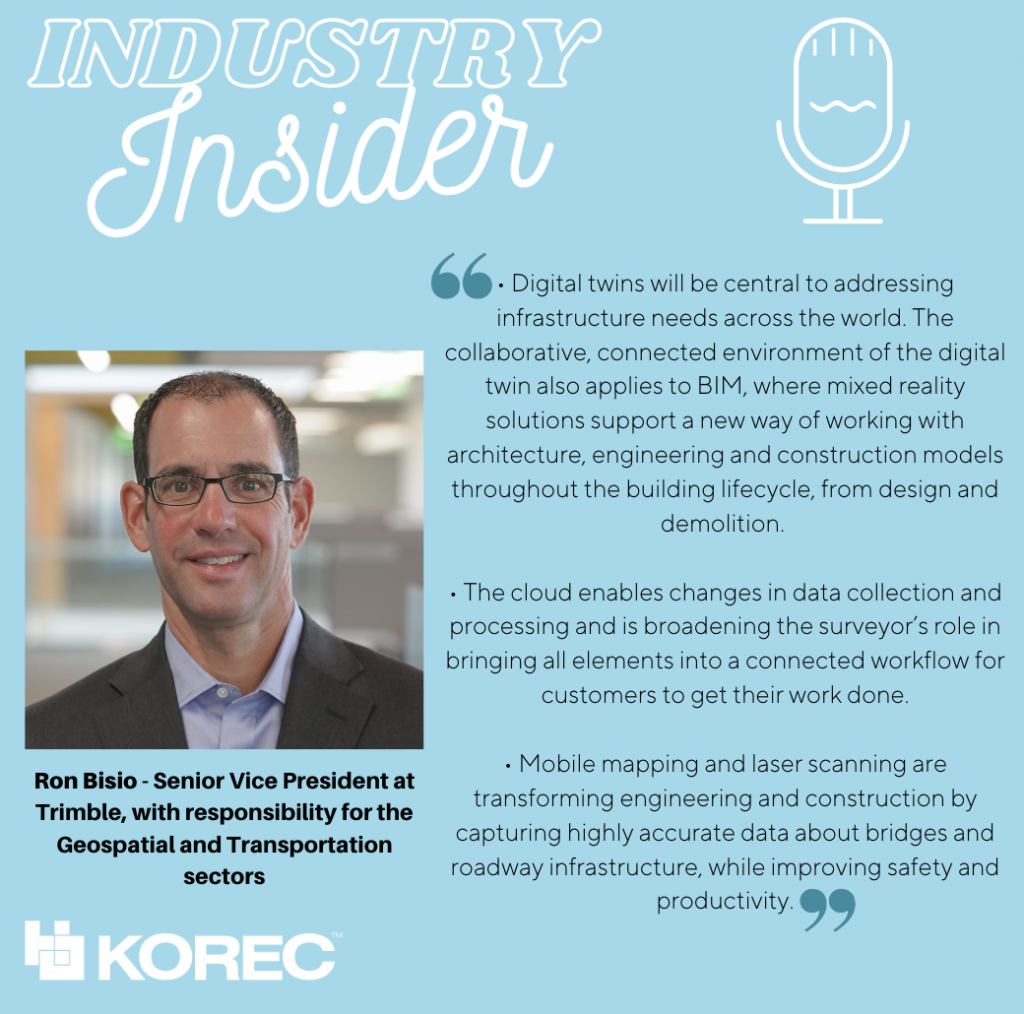
Ron joined the company in 1996 and has held several marketing, sales and general management positions prior to taking over worldwide responsibility for Trimble Geospatial in 2015. He earned a master’s degree in business administration from the University of Denver, a master’s in regional planning from the University of Massachusetts and an undergraduate degree in geographic information systems & cartography from Salem State University in Salem, Mass.
Ron’s three most rated geospatial industry innovations/changes
• Digital twins will be central to addressing infrastructure needs across the world. The collaborative, connected environment of the digital twin also applies to BIM, where mixed reality solutions support a new way of working with architecture, engineering and construction models throughout the building lifecycle, from design and demolition.
• The cloud enables changes in data collection and processing and is broadening the surveyor’s role in bringing all elements into a connected workflow for customers to get their work done.
• Mobile mapping and laser scanning are transforming engineering and construction by capturing highly accurate data about bridges and roadway infrastructure, while improving safety and productivity.
Gavin Schrock, Licensed land surveyor and consulting editor of GoGeomatics

Gavin Schrock is also a practicing, licensed land surveyor, technology writer, administrator of a cooperative real-time GNSS network (RTN) and consulting editor of GoGeomatics. He has worked in surveying, mapping, geodesy, monitoring, data management, satellite navigation, and GIS in public works, commercial development, defense, and utilities. @schrockg
Gavin’s four most rated geospatial industry innovations/changes
• Practical Augmented Reality for Construction and Surveying
The face-box AR systems, like we see promoted in consumer markets, were never going to be practical—or safe—for field or worksite environments. The realisation of true “mixed reality” was long overdue for AEC applications; I’d been waiting for this for decades, ever since I saw those heads-up displays in fighter aircraft and thought “why can’t we have this in the field?” Then along came the Trimble XR10 in 2019, based on the HoloLens 2, later productized as for construction layout earlier this year, powered by the FieldLink MR application. The future just got quite bit closer. Ok Trimble, now give us a tilt-prims-pole to go with it!
• Cobots for Surveying
Sure, we are long way from full-on robots as field crews, but the benefits or automation, particularly to boost productivity and reduce common sources of error are already being realised with “cobotics” instruments. A “cobot” is often defined as “a computer-controlled robotic device designed to assist a person”. A prime example in surveying is advanced scanners like the X7 that self-calibrate, perform automated fine levelling, and progressively self-register multiple scans. Another is the robotic platforms, like the surveying robo-dogs (and follow-along equipment pods) that take their cues from their human party chief/coach. Expect to see robotic total stations and UAS get a bit more “coboty” in the near future.
• The Time to Upgrade Your Survey GNSS is Now
It’s good move to help firms keep up with the present more-work-than-they-can-handle situation. But also, in this tight job market, the latest kit can help attract and retain staff. GNSS rovers have undergone a dramatic leap forward just in the past few years with the Galileo and Beidou constellations reaching full complement in 2020. Rover manufacturers had to boost processing power and completely revamp RTK engines, like in the R12, to fully leverage an expanded slate of modernized signals. There have been noticeable gains in speed, multipath mitigation, ability to work in sky-view-challenged environments—not to mention sensor integration like no-calibration tilt.
• Pay-as-you-go High Precision GNSS
A unique combination of GNSS hardware and software-as-a-service (SaaS) provides very affordable high-precision—on an as-needed basis. Late last year, I got to test-drive the Trimble DA2/Catalyst system, and found that under most conditions, it performed just as well as a high-end surveying rover. With a small investment in an antenna, you use credits to essentially “rent” the high precision receiver/RTK engine. Perfect for those with occasional or seasonal needs or seeking to outfit a large team for a term project. In 2017, the first generation of Catalyst demonstrated that software-defined-GNSS-receivers were practical; this latest gen system improves the user experience, better leverages multiple constellations.
A trio of news stories celebrating the support that both KOREC and Trimble are providing to the education sector across the UK
There isn’t much that’s more important than ensuring the next generation are informed, enthused and inspired to join us in the exciting world of engineering, construction and the built environment.
In how many other industries can you make such a direct and positive change in how we design, build and maintain the spaces in which we live, work and play?
That’s why we’re delighted to highlight 3 recent stories that do just that;
KOREC & National Highways make a Big impact
Our team were delighted to support National Highways at the recent Big Bang Fair in Birmingham.
The 3-day event saw tens of thousands of children aged 11-14 descend on the NEC to get involved in all things STEM (science, technology, engineering and maths).

The KOREC team were on hand to showcase the very cool technologies that are being utilised to made the collection, sharing and understanding of spatial data easier and more intuitive. The star of the show was most certainly the Trimble XR10 headset. The team loaded various digital models including dinosaurs, robots and an airplane into the device, which the kids could then view and explore!
Check out more photos of the event and the team, here!
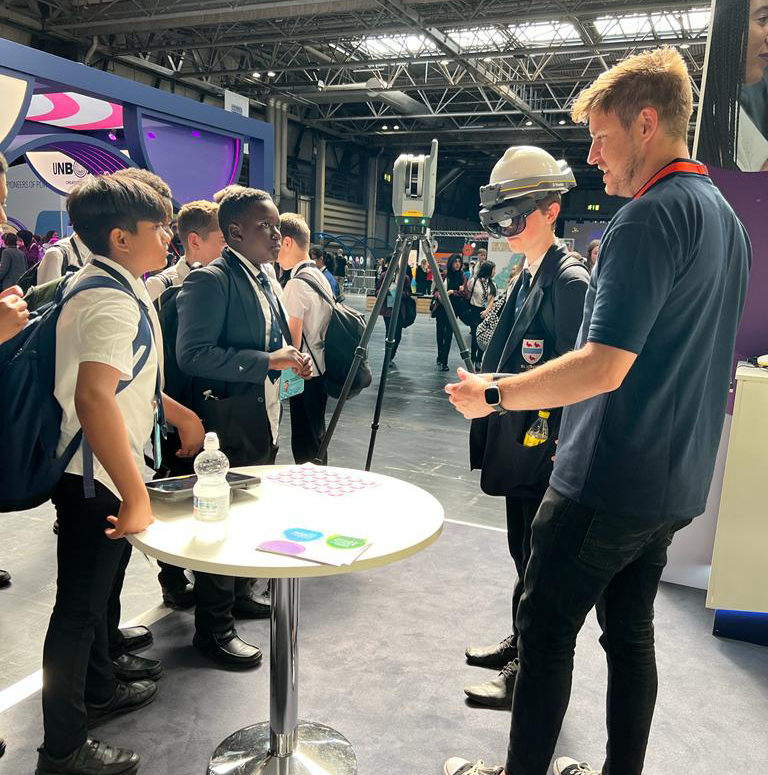
Trimble Technology lab expands in Edinburgh
Trimble and Edinburgh Napier University are celebrating the expansion of the Trimble Technology lab – the first of its kind in the UK.
Click here or the link below to read the complete story over on the North Edinburgh News site.
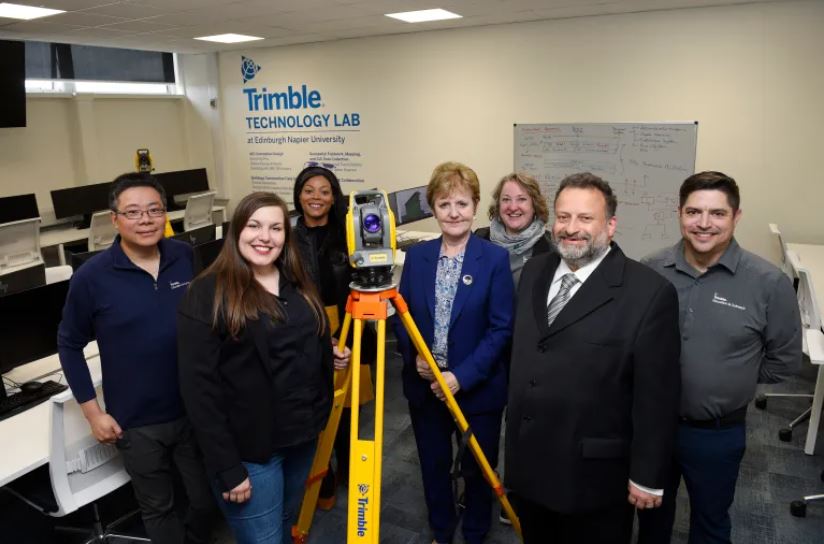
SMB College Group invest in Trimble Technology
Leicestershire-based SMB College Group has recently invested over £80,000 in Trimble technology, supplied by KOREC Group.
The college is a leader in Construction T level courses – preparing its students for work in the construction and engineering sectors including quantity surveying, civil engineering, project management and architecture.
The equipment includes some of Trimble’s most cutting-edge digital construction solutions, including the X7 laser scanner, the XR10 mixed reality headset, and the S5 robotic total station.
Read the full press release on the SMB College Group site

Next Generation is KOREC’s higher education strand – it’s how we inspire, support and train the institutions and the students who are the future workforce of our industry.
If you’d like to know more about Next Generation, or how we can help you, why not get in touch?
We are delighted and proud to announce that our KOREC Group CEO, Alan Browne, has been named on the EY Entrepreneur of the Year shortlist for 2022. Alan’s nomination is for ‘Established Entrepreneur’, one of three categories that also include ‘Emerging Entrepreneur’ and ‘International Entrepreneur’. Following judging of the shortlist the overall winner for Ireland, who will also be a global finalist, will be announced in November.

EY Entrepreneur Of The Year is a unique global programme running in more than 60 countries that recognises entrepreneurial achievement among individuals and companies that demonstrate vision, leadership and success. All finalists will be invited to join the EY networking event in Austin, Texas.
In Alan’s case, the nomination is a fitting recognition of his 27 years as CEO of KOREC that has culminated in a recent period of massive growth for the company resulting in a recruitment drive to fill 30 new positions, in a range of departments, across the UK and Ireland.
Alan Browne said: “I’m delighted to receive this nomination because it’s a truly exciting recognition of what we have achieved at KOREC over the years in a demanding, technology led environment. Our experience has allowed us to build and define our company culture and that means we’ve also created a great workplace, a great team and a world-class ethos.”
Additional information about why Alan was shortlisted
Alan has been entrepreneurial from an early age. At just 27 years old he started a company in Ireland called PCI with a single employee. He felt that large machines on construction sites could be used far more effectively and accurately if they were equipped with a technology called Machine Control (based on laser measurement) that was still very much in its infancy.
In the first year of working, the company had a turnover of £110k. Today KOREC Group will turnover £35m across the Group. From the initial days of just two employees, KOREC now employs over one hundred people and is growing all the time. Currently, KOREC is seeking to recruit for 30 new posts in 2022.
Alan’s strength, and that of the KOREC Group, lies in his ability to spot key business areas whilst they are still in their infancy and in some cases, whilst there is still opposition to the technology. A great example of this is his move into the commercial drone market in 2011 becoming the first in the UK to do this. He worked closely with drone manufacturer senseFly to become one of their most influential partners. This relationship is still strong today and despite initial opposition, many survey companies are now reliant on drone technology and see drones as a vital addition to the surveyor’s toolbox.
Most recently Alan has moved KOREC towards robotics, again a technology that is still in its earliest phases within the construction and survey industries. This move has seen KOREC working with major engineering contractors in the UK and Ireland as they adopt Spot the Dog, an agile robot developed by Boston Dynamics. Teamed with Trimble laser scan technology, Spot is equipped to carry out 3D laser scans, autonomously, in conditions inhospitable to a surveyor or to just carry out mundane and repetitive tasks to free up skilled engineers or surveyors to focus on other aspects of a project.
Alan has a proven ability to spot key business areas early, including niche markets that require time and investment, along with the ability to understand a customers’ specific and unique project requirements. He has placed KOREC in an advantageous position by connecting customers to the global leading software, hardware, and services technology company that is Trimble, whilst retaining local knowledge and a sense of community. This is what has enabled him to bring cutting edge technology to projects, whilst also developing bespoke software solutions that fit the bill precisely.
The KOREC mission is a simple and one that Alan adheres closely to in every decision he makes whilst also ensuring that the company reflects this overall vision.
The KOREC Mission:
When operating in the natural and built environment, consistent success demands accuracy, safety and speed, whilst reducing costs and environmental impact.
At KOREC, we believe embracing geospatial solutions will transform your outcomes and deliver that success.
KOREC’s mission is to empower you to measure, map and manage the natural and built environment.
Combining industry knowledge, with intuitive software, and world-leading positioning technology, KOREC transforms your operations bringing certainty to your decision making.
Finally, Alan has also invested a lot of time and effort in creating a KOREC culture that is both fun and rewarding to work in.

This Monday may be a bank holiday, but this year another holiday is taking place on the same day. Eid al-Fitr (festival of breaking the fast) will be celebrated by Muslims all around the world as the month of Ramadan comes to an end.
But what is Ramadan? Here, KOREC’s Digital Marketing Apprentice Ikra Taj educates us on Ramadan, and what it means to her.
Ramadan is the ninth month in the Islamic calendar and every year the start date varies and is decided at the sighting of the moon. It is a religious ceremony that marks the 30 days in which the Quran (Holy book of Islam) was revealed to our last prophet. This month is possibly the most anticipated month of the Islamic calendar; a month that Muslims across the globe yearn and crave to see again. During Ramadan Muslims spend an entire month fasting from sunset to sunrise, this means we cannot eat or drink anything from sunset to sunrise. Aside from fasting Ramadan is a time for spiritual reflection, to help those in need and to spend time with loved ones.
Every year I often get asked the same questions around fasting. There’s always the interest of how we observe this sacred month and then there’s the shock of how intense the requirements of fasting are:
“So you can’t eat anything from sunset to sunrise?!”
“Not even water?!”
“I could never do that!”
I understand it does sound pretty full on but the reality is Ramadan is doable and so rewarding. It is even scientifically proven that intermittent fasting has multiple health benefits. However, we don’t fast because God wants us to starve, instead it’s a time to empty our stomachs and feed our souls.
Fasting is compulsory for all Muslims although there are some exemptions, some are exempt from fasting due to illnesses, pregnancy or old age. In these cases, If the individual is not able to make up these fasts at a later date, they must feed one poor person for each fast missed.
Ramadan is something I’ve always observed since a young age. For me it is a time of quiet reflection and self-discipline; I like to pray, recite the Quran and give extra charity during this month to better myself and improve my character. It’s also a time where I am conscious of my actions more so than on a typical day as I want to be rewarded by God for the good I do in this month.
In my younger years Ramadan for me often used to be a challenge, all I thought about was food and often I spent my days counting down the hours to sunset so I could eat. Luckily this has changed! As I’ve grown older I normally overcome the effects of fasting within the first few days, the body does adjust fairly fast and although I miss my guilty pleasures the feeling of fasting makes me so much happier.
Instead of having food on my mind I make the effort to spend more time with my family, prepare meals for my loved ones and increase my remembrance of God. Working from home also has its benefits as I am able to preserve my energy by not traveling or walking around much. It also helps when working in an environment where those around you care and help you through this month, the little things like getting checked up on by work colleagues during my working day always brings a smile to my face and makes this month that much more amazing. So a special thank you to Stuart and Harriet who have looked after me well and been so understanding, I appreciate you!
As a small cake business owner my days are always busy with a high influx of orders coming in, from everyone wanting to gift their friends and family edible gifts to celebrate Ramadan. I love this part, as my spare time is spent doing what I love and bringing smiles to faces.
So the question remains why do we fast in Ramadan?
Firstly, it is one of the pillars of Islam (obligatory acts Muslims must carry out). The Quran also states those who believe must fast. Fasting has been a way of those way before us and its intention is to make us more conscious of our Lord. When we see our physical intake of blessings i.e. food being taken away from us we instantly become more mindful of who bestowed those blessings upon us. This makes us grateful and In turn helps us live positively and do good. As well as withholding food we must stay away from using bad language, smoking, immoral acts and anger.
When a Muslim predecessor once asked “why is fasting instituted?” It was replied by “so that the rich will taste hunger and thus will not forget the hungry”. Through the experience of fasting we gain a greater depth of understanding for those who have little or no food, this helps us to have more empathy. Therefore, during Ramadan Muslims push to be charitable by donating to charities and feeding the less fortunate.
What may surprise some is that Muslims enjoy Ramadan so much that they grieve when it comes to an end. We come to the realisation that true happiness is in feeding the soul and being satisfied with your sustenance, that prayer is better than sleep and that charity is better than consumption.

Last month we said goodbye to one of our longest-serving employees – and in doing so closed a chapter of KOREC’s history.
When Group Financial Controller Helen Palmer (nee Walsh) decided to ‘hang up her abacus’ after 22 years in the business, there ended the last connection to the original founders of Survey Supplies.
A Little History Lesson
Survey Supplies was founded in Liverpool by father and son, George and Graham Walsh in 1967. As with many family enterprises, Helen Walsh, Graham’s daughter and George’s granddaughter, was roped in to assist – working in the finance department as a teenager during her summer holidays.
Helen clearly caught the bug – heading to university to study Maths with statistics, and then training as a Chartered Accountant with a firm in Liverpool.
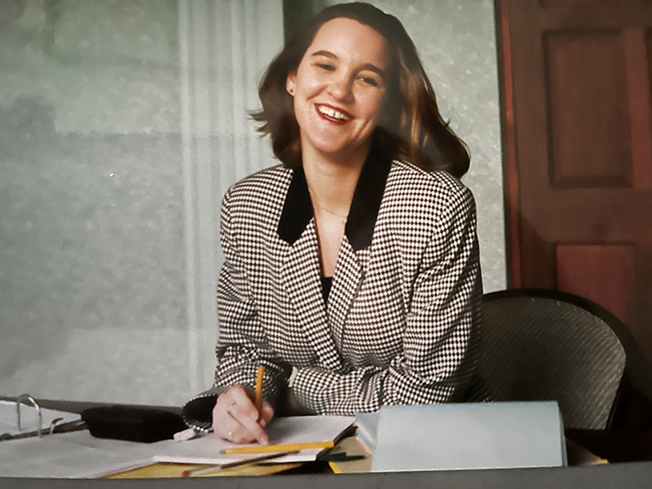
In 1999 Helen returned to the finance department at Survey Supplies. When Survey Supplies Ireland was established– a brand new enterprise for the company, Helen was tasked with the accounting functions.
One of the most significant changes came in 2005 when current CEO Alan Browne purchased Survey Supplies, and rebranded the organisation to KOREC. Although clearly a significant change for Helen, she confesses that these later years have been the ones she will look back on most fondly.
A Fond Farewell
Never one to miss out on a party, Helen made the decision to retire at the tail end of 2021 – giving the KOREC team plenty of time to plan her farewell party.
The team didn’t disappoint. A night out at Bongo’s Bingo (bingo – but not as you know it!) was enjoyed by the Liverpool office team, although Helen was gutted not to take home the glitterball helmet…
A rather more sedate party was held in the Liverpool office, where the team enjoyed a buffet feast (thank you Rachel!) and an absolutely giant cake, which Helen ceremoniously cut.
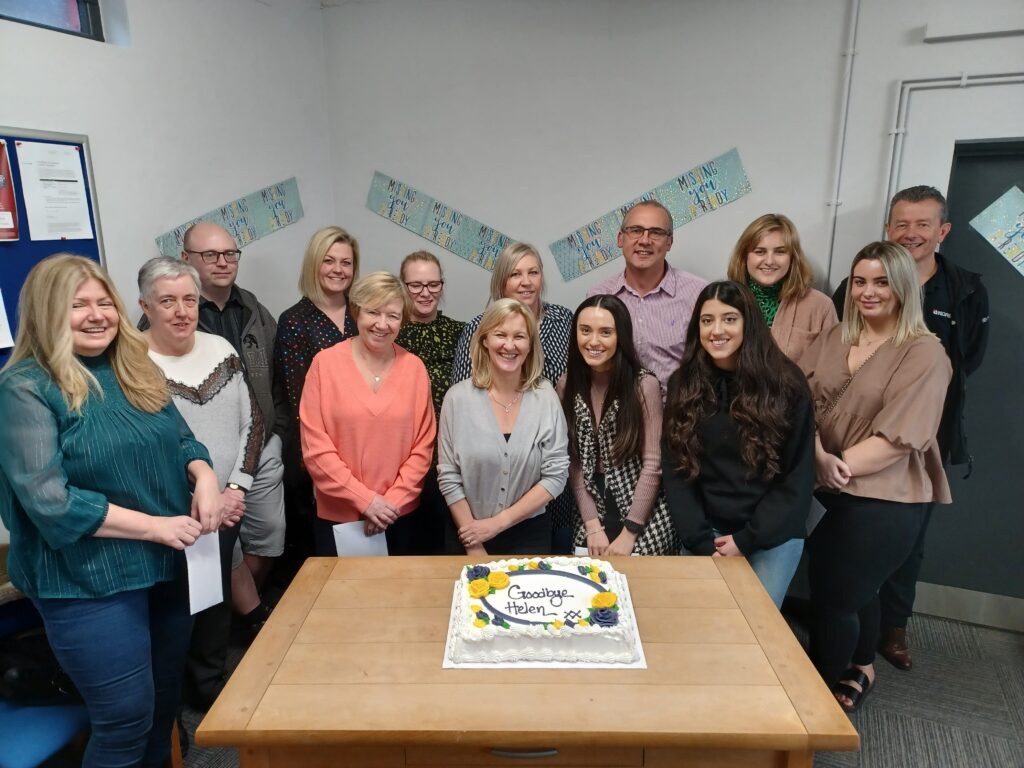
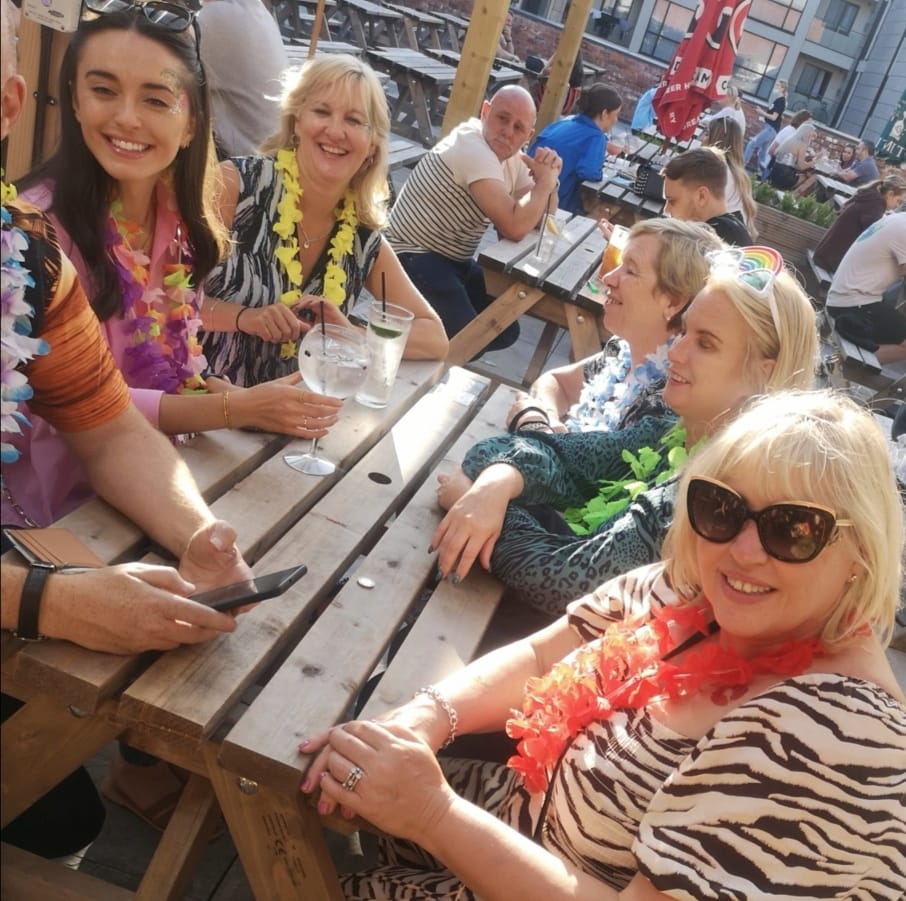
Helen will be greatly missed by all who worked with her – not least Finance Director David Hodkinson who singled out her ‘fantastic work and dedication’ during their 16 years as colleagues.
Happily, Helen is based just up the road from the Crosby office, so we expect to be seeing Helen and getting regular updates on her latest golf handicap / caravan holiday escapades!
From all of us at KOREC, we thank you Helen and wish you many happy years on the golf course!
Trust is a funny thing. It can take years to build, yet can be destroyed in days.
All and any relationships, may they be business or personal, ultimately succeed or fail due to trust.
In the era of fake news, accusations of green-washing, and with faith in our political systems at an all time low (in a recent Ipsos Mori poll, politicians finished in last place in the trust race), we thought it was high time to establish why we think KOREC stands out from the rest.
So we’re launched our 6 pillars of trust – 6 reasons why we think KOREC is an organisation that you can rely on;
We’re Committed!
Tracing our roots back to 1967, KOREC has been in the geospatial business for over 50 years. That sort of longevity doesn’t come easily – and we think proves our commitment to, and expertise of, the industries that we serve.
This longevity is bolstered by geographical spread of KOREC’s regional consultant and technical support teams. In short – we’re located where you are. So whether it’s Enda Fox in Belfast, Leigh Rowell in Northumberland, or Abel Varela Abelleira in London – you know there’s a KOREC-er who knows your area.
Sincerely, Yours
We understand that trust is built from the inside out. The separation caused by COVID and home-working only served to reinforce this fact. Over the past few years, we’ve been working hard on improving our internal company communications. We launched Lunch ‘n’ Learns in 2020, and we introduced Yammer in 2022. Both platforms seek to improve the flow of information around our organisation, ensuring that all colleagues are well-informed and up to date.

We’ve also worked hard on the clarity of our public messaging. After all – you’re busy, we’re busy – so let’s simplify our message and get straight to the point. Our marketing team’s ethos is to get you connected to the right information, or the right person, as quickly as we can.
You Can Lean On Us
We think this one goes without saying, but we are proud to supply the most reliable, robust and trustworthy kit in the geospatial industry.
In just the last few years alone, Trimble has released some extraordinary solutions onto the market – the tilting R12i, wunderkid X7 scanner, Catalyst DA2 and MX50 mobile mapping system to name a few.

As many surveyors will know, not all survey equipment is created equal, and it pains us to see surveyors suffering with kit that fails in the lightest of rain showers. It’s very much a part of our mission to connect you with the right kit for the job – in order to make your life easier.
Integrity – it’s Integral to Us
Forgive us the wordplay. Rather than selling you a one-off bit of kit, we strive to provide end-to-end solutions that solve your complete problem – not just a part of it. It’s our belief that employing one solution from one provider increases your efficiencies and smoothens your workflow – not to mention just one port of call if you need help or assistance!
Core Competency
A section of the business that brings us pride are our office-based and regional technical support teams. In annual surveys and feedback forms, these guys are usually voted the top of the bunch (much to the chagrin of other departments!)

But this is no accident. Both our sales and support teams undergo rigorous training – both at the beginning of the job, and throughout. With the majority of our team being trained surveyors and engineers in their own right, they certainly understand the pain points that you experience.
A Lovely Consistency
Taking all of the above into account, whether it be training, education, equipment or messaging, we aim to be consistent in all that we do. With a growing organisation operating across 2 nations, this is a constant challenge that needs constant work. How do we do it?
Regular, clear and constructive communication is encouraged throughout KOREC from the top-down – whether it’s CEO Alan’s video updates, our regular, informative Lunch ‘n’ Learns, or our bi-annual get togethers.
Transparency
Okay we said 6, but here’s 1 more for luck. We aim to be as transparent as we can. Not only do we regularly ask you, our customers, for your opinion – we also publish the results and share them with you.
So in the spirit of transparency, what do you make of our 6 pillars? Anything we missed out? What else could KOREC be doing to increase your trust?
Why not let us know via this feedback form?

